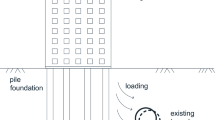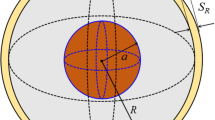Abstract
In the realm of constructing urban underground spaces, it is imperative to address the impact of tunnel leakage on the surrounding environment. This paper introduced a theoretical analysis to investigate the localized water leakage's influence on adjacent pile foundations. A pore pressure distribution function, accounting for localized leakage water, was formulated. Integrated with the seepage control equation, this function facilitated the calculation of additional stress imposed on piles due to tunnel localized water leakage. Employing the Pasternak foundation model, an analytical solution was developed to assess the lateral performance of adjacent piles under localized water leakage conditions. This approach was compared with numerical simulations to validate the reliability of soil seepage fields and pile lateral performance resulting from localized tunnel leakage at different positions. Through comprehensive parameter analysis, it was observed that the width of the leakage joint significantly influenced pile lateral responses, manifesting in three distinct stages: linear increase, nonlinear gradual augmentation, and stabilization. Different positions of the lining leakage joint yielded varying effects on adjacent piles' lateral responses, with closer proximity intensifying the impact on the pile. When leakage joints were situated near the pile toe, a pronounced negative bending moment was generated. Furthermore, this study summarized the influence range of tunnel localized leakage adjacent to piles. It established that the maximum pile-tunnel horizontal distance inducing lateral pile responses due to tunnel localized leakage was set at 8 times the pile diameter (8 Dp). Additionally, tunnel leakage influences should be considered when the pile length exceeded 0.6 times the depth of the tunnel axis.


















Similar content being viewed by others
Data availability
Data Availability The datasets generated during and/or analyzed during the current study are available from the corresponding author on reasonable request.
References
Cao L, Zhang D, Shen X, Su J, Fang H, Su D (2021) Horizontal mechanical responses of single pile due to urban tunnelling in multi-layered soils. Comput Geotech 135:104164
El Tani M (2003) Circular tunnel in a semi-infinite aquifer. Tunn Undergr Space Technol 18(1):49–55
Fernández G, Alvarez TA Jr (1994) Seepage-induced effective stresses and water pressures around pressure tunnels. J Geotech Eng 120(1):108–128
Gong C, Ding W, Xie D (2020) Parametric investigation on the sealant behavior of tunnel segmental joints under water pressurization. Tunn Undergr Space Technol 97:103231
Huang L, Ma J, Lei M, Liu L, Lin Y, Zhang Z (2020) Soil-water inrush induced shield tunnel lining damage and its stabilization: A case study. Tunn Undergr Space Technol 97:103290
Huangfu M, Wang M, Tan Z, Wang X (2010) Analytical solutions for steady seepage into an underwater circular tunnel. Tunn Undergr Space Technol 25(4):391–396
Kolymbas D, Wagner P (2007) Groundwater ingress to tunnels—the exact analytical solution. Tunn Undergr Space Technol 22(1):23–27
Lee S, Jung J, Nam S, Lee I (2007) The influence of seepage forces on ground reaction curve of circular opening. Tunn Undergr Space Technol 22(1):28–38
Li L, Chen H, Li J, Sun D (2021) A semi-analytical solution to steady-state groundwater inflow into a circular tunnel considering anisotropic permeability. Tunn Undergr Space Technol 116:104115
Loganathan N, Poulos HG, Stewart DP (2000) Centrifuge model testing of tunnelling-induced ground and pile deformations. Géotechnique 50(3):283–294
Mair RJ (2008) Tunnelling and geotechnics: new horizons. Géotechnique 58(9):695–736
Masset O, Loew S (2013) Quantitative hydraulic analysis of pre-drillings and inflows to the Gotthard Base Tunnel (Sedrun Lot, Switzerland). Eng Geol 164:50–66
Ng CWW, Lu H (2013) Effects of the construction sequence of twin tunnels at different depths on an existing pile. Can Geotech J 51(2):173–183
Palmer JHL, Belshaw DJ (1980) Deformations and pore pressures in the vicinity of a precast, segmented, concrete-lined tunnel in clay. Can Geotech J 17(2):174–184
Park K, Owatsiriwong A, Lee J (2008) Analytical solution for steady-state groundwater inflow into a drained circular tunnel in a semi-infinite aquifer: a revisit. Tunn Undergr Space Technol 23(2):206–209
Pasternak PL (1954) On a new method of analysis of an elastic foundation by means of two foundation constants. Gos. Izd. Lit. po Strait I Arkh
Peng YC (2013) Nonlinear behavior and fluid-structure interaction model of shield tunnel segments. Doctoral dissertation. Tongji University Shanghai
Shin J, Kim S, Shin Y (2012) Long-term mechanical and hydraulic interaction and leakage evaluation of segmented tunnels. Soils Found 52(1):38–48
Shin JH, Addenbrooke TI, Potts DM (2002) A numerical study of the effect of groundwater movement on long-term tunnel behaviour. Géotechnique 52(6):391–403
Soomro MA (2021) 3D finite element analysis of effects of twin stacked tunnels at different depths and with different construction sequence on a piled raft. Tunn Undergr Space Technol 109:103759
Tanahashi H (2004) Formulas for an Infinitely Long Bernoulli-Euler Beam on the Pasternak Model. Soils Found 44(5):109–118
Tang Y, Chan DH, Zhu DZ, Guo S (2017) An analytical solution for steady seepage into a defective pipe. Water Supply 18(3):926–935
Waite ME, Ge S, Spetzler H (1999) A new conceptual model for fluid flow in discrete fractures: an experimental and numerical study. J Geophys Res: Solid Earth 104(B6):13049–13059
Wang F, Huang H (2020) Theoretical analysis of the joint leakage in shield tunnel considering the typical deformation mode. Int J Geomech 20(12):4020218
Wongsaro J, Soga K, Mair RJ (2013) Tunnelling-induced consolidation settlements in London Clay. Géotechnique 63(13):1103–1115
Wu H, Shen S, Chen R, Zhou A (2020) Three-dimensional numerical modelling on localised leakage in segmental lining of shield tunnels. Comput Geotech 122:103549
Wu H, Shen S, Liao S, Yin Z (2015) Longitudinal structural modelling of shield tunnels considering shearing dislocation between segmental rings. Tunn Undergr Space Technol 50:317–323
Yoo C (2005) Interaction between tunneling and groundwater—numerical investigation using three dimensional stress–pore pressure coupled analysis. J Geotech Geoenviron Eng 131(2):240–250
Yu J, Zhang C, Huang M (2013) Soil–pipe interaction due to tunnelling: assessment of Winkler modulus for underground pipelines. Comput Geotech 50:17–28
Zeng C, Zheng G, Xue X (2017) Wall deflection induced by pre-excavation dewatering in large-scale excavations. Chin J Geotech Eng (in Chinese) 39(6):1012–1021
Zhang DM, Huang ZK, Yin ZY, Ran LZ, Huang HW (2017) Predicting the grouting effect on leakage-induced tunnels and ground response in saturated soils. Tunn Undergr Space Technol 65:76–90
Zhang Q, Hou Z, Huang G, Cai Z, Kang Y (2015) Mechanical characterization of the load distribution on the cutterhead–ground interface of shield tunneling machines. Tunn Undergr Space Technol 47:106–113
Zhang R, Zheng J, Zhang L, Pu H (2011) An analysis method for the influence of tunneling on adjacent loaded pile groups with rigid elevated caps. Int J Numer Anal Meth Geomech 35(18):1949–1971
Zhang Z, Huang M, Xu C, Jiang Y, Wang W (2018) Simplified solution for tunnel-soil-pile interaction in Pasternak’s foundation model. Tunn Undergr Space Technol 78:146–158
Zhou Y, Su K, Wu H (2015) Hydro-mechanical interaction analysis of high pressure hydraulic tunnel. Tunn Undergr Space Technol 47:28–34
Acknowledgements
The majority of the work presented in this paper was funded by the National Natural Science Foundation of China (Grant Nos. 51878157, 52308341), the Natural Science Foundation of Jiangsu Province (Grant No. BK20181282), and the China Scholarship Council (CSC202106090083). These financial supports are gratefully acknowledged.
Author information
Authors and Affiliations
Contributions
WG contributed to conceptualization, methodology, software, validation, writing—original draft. LT contributed to conceptualization, writing—review and editing, funding, supervision. WL contributed to validation, writing—review and editing. XY contributed to conceptualization, writing—review and editing. HL contributed to conceptualization, methodology, funding, writing—review and editing, and supervision.
Corresponding authors
Ethics declarations
Conflict of interest
There are no financial conflicts of interest to disclose.
Additional information
Publisher's Note
Springer Nature remains neutral with regard to jurisdictional claims in published maps and institutional affiliations.
Appendix A
Appendix A
The traditional conformal mapping method of tunnel leakage model is shown in Fig.
18. The outer diameter of the tunnel is r2 and the inner diameter is r1. h is the cover depth C plus the outer diameter of the tunnel r2, and the tunnel is buried in saturated soil. To simplify the solution to the problem, the following assumptions are put forward: (1) the soil mass is homogeneous, continuous and isotropic; (2) Both soil and water are incompressible, and the water level remains constant at the surface; (3) The seepage is irrotational and stable, and the movement law follows Darcy’ s law; (4) The pore water pressure at the inner boundary of tunnel lining is zero. The water head at the outer boundary of the lining is Hg, which is a variable studied in this paper.
According to Darcy’s law and conservation of mass, the two-dimensional fluid around the tunnel can be expressed in polar coordinates of Laplace equation as follows:
where φ is the total water head at any point in the seepage field, equal to the pore water head plus the potential head in Eq. (A-2)
where p is pore pressure, γw is the weight of water and z is the potential head.
The total head acting on the position with radius r can be obtained by solving the general solution of Eq. (A-1) [31].
where C1, C2, C3 and C4 are constants, which are determined by the drainage boundary conditions at the water level and the outer radius of the tunnel.
The boundary conditions of polar coordinate plane water head are as follows
where
Taking the boundary conditions into the Eq. (A-3), the total water head can be obtained
Rights and permissions
Springer Nature or its licensor (e.g. a society or other partner) holds exclusive rights to this article under a publishing agreement with the author(s) or other rightsholder(s); author self-archiving of the accepted manuscript version of this article is solely governed by the terms of such publishing agreement and applicable law.
About this article
Cite this article
Gu, W., Tong, L., Liu, W. et al. Prediction of tunnel localized water leakage influences on adjacent lateral pile responses in saturated clay. Acta Geotech. (2024). https://doi.org/10.1007/s11440-024-02274-3
Received:
Accepted:
Published:
DOI: https://doi.org/10.1007/s11440-024-02274-3





